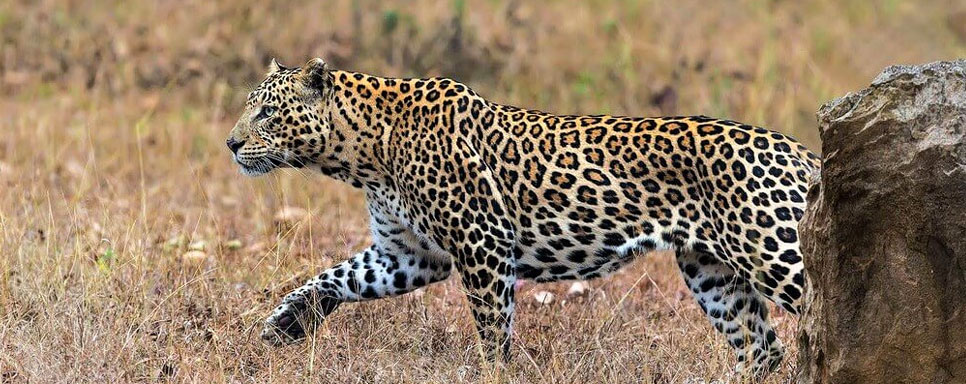Important and Interesting Facts about Indian Leopards

The Indian Leopard, known for its elusive nature, stands out as one of the most captivating and beloved big cat species. Its remarkable adaptability to diverse environments contributes to its success in navigating challenges such as habitat destruction, poaching, and the encroachment of human settlements. A notable phenomenon within this species is melanism, where the entire skin darkens, resulting in what is commonly referred to as the Black Panther. It's important to clarify that Melanistic Leopards are not a separate species, dispelling a common misconception among people.
The Indian Leopards at a Glance• Family - Felidae
• Subfamily - Pantherinae
• Genera - Panthera
• Common name - Indian Leopard / Leopard
• Life span - 12-17 years
• Body weight - Females: 28 kg to 60 kg and Males: 50 kg to 75 kg
• Height - 45 - 80 cm
• anines - 2-3 inches
• Head & Body Length - Males: 4 to 4.5 ft. and Females: 3.5 to 3.19 ft
Leopards after BirthLeopard cubs enter the world blind and nearly hairless, with coats sporting barely visible spots that mature over time. For the initial three months, they remain within their dens, relying entirely on their mothers for sustenance. Mothers often relocate their cubs to ensure their safety. Between 12 to 18 months, these cubs reach an age where they can hunt and fend for themselves.
Behaviour of Indian LeopardsSimilar to other leopard sub-species, Indian leopards are solitary hunters adept at nocturnal camouflage. They descend from trees during the day to pursue prey. In regions where they coexist with formidable predators like Bengal tigers, Dhole, or Striped Hyenas, leopards often haul their prey into trees for protection. These opportunistic hunters prioritize strength over speed, boasting large skulls and powerful jaw muscles, ideal for subduing medium-sized herbivores. Their daily diet includes common prey such as Nilgai, Sambar Deer, Langur, Wild Boar, Indian Hare, Peafowl, and more.
Instance of Leopard-Human Peaceful Co-existenceRecognized as a Leopard Conservation Zone since 2003, Bera is nestled within the picturesque Aravalli Range of Rajasthan, with the sprawling Jawai Dam gracing its surroundings. This region goes beyond its conservation efforts, as it has become a testament to the symbiotic relationship between nature and communities. Jawai-Bera not only hosts a thriving population of leopards but is also the ancestral home of the nomadic Rabari Tribe. The Rabari tribals have gracefully coexisted with the majestic spotted cats, showcasing a unique example of peaceful harmony between human settlements and wildlife.
This cohabitation reflects a delicate balance where the Rabari Tribe and leopards share the same landscapes, demonstrating the potential for harmonious living between indigenous communities and the diverse ecosystems they inhabit. Jawai-Bera stands as a living canvas, depicting the beauty of coexistence and the significance of conservation efforts in preserving the rich biodiversity of the Aravalli region. While spotting leopards in Jawai National Park is quite common. The tribals are never harmed by the presence of leopards around them. If the livestock of the Rabari tribals are preyed on by the leopards, they consider it as an offering to Lord Shiva.
Threats and Conservation of Indian LeopardsThe most common threats to Indian Leopards
• Poaching
• Loss of natural habitats
• Human-leopard conflict
• Road accidents
The leopard population has faced a severe threat due to rampant poaching for their skins and body parts, driven by the illegal wildlife trade. Disturbingly, between 1994 and 2000, over 3000 leopards fell victim to this illicit activity in India. The most recent assessment by the International Union for Conservation of Nature (IUCN), categorizing all leopard subspecies as 'Vulnerable,' underscores the urgent need for a comprehensive examination of the Indian leopard population.
There is a glimmer of hope despite these challenges. The encouraging news is that the estimated leopard population in India has witnessed an 8% increase, rising from 12,852 in 2018 to 13,874 in 2022. This positive trend is a result of the fifth-cycle leopard population estimation conducted by the National Tiger Conservation Authority (NTCA) and the Wildlife Institute of India (WII), in collaboration with State Forest Departments. This collaborative effort signifies a step forward in conservation initiatives, highlighting the importance of concerted actions to protect and preserve these magnificent creatures.